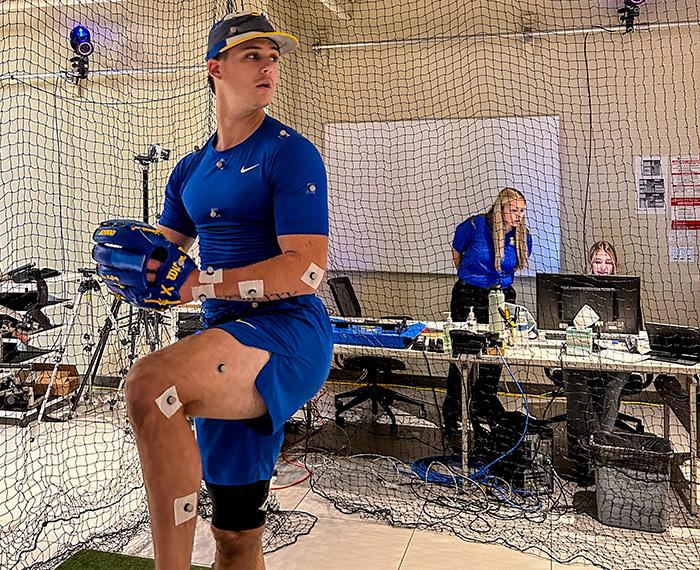
Subscribe to Pittwire Today
Get the most interesting and important stories from the University of Pittsburgh.These Pitt researchers are investigating the biomechanics of baseball

This piece was originally published in Pitt Ed magazine. Read the Summer 2025 edition, out now.
The most elite pitchers can throw blistering fastballs that register 100 miles per hour on the radar gun and deadly breaking balls that nose-dive right as the batter starts to swing. How can understanding the science behind their pitching motions be used to improve performance and reduce the risk of injury?
Researchers at the University of Pittsburgh are working with the Pitt baseball team to answer these questions through a project assessing the biomechanics of the players. The first round of measurements was taken in fall 2024 with an assessment of more than a dozen members of the pitching staff. Later this year, the hitters will be assessed, followed by an analysis of the pitchers.
“In general, biomechanics and motion capture provide an understanding of how we move, how we can improve movement efficiency and effectiveness, why injuries occur, and how to prevent or reduce these injuries,” says April Chambers, an associate professor in Pitt’s School of Education.
The data can protect the health of players and give the team a competitive edge.
“We use biomechanical equipment to identify key metrics such as elbow torque, arm speed, and body angles or velocities at critical time points in the throwing motion. Pitching with elbow torques that are too high are associated with injuries such as ulnar collateral ligament (UCL) tears, which are season-ending injuries that require Tommy John surgery (named after the first Major League Baseball pitcher to undergo this surgery),” says Chambers.
Chambers, who has a secondary appointment in the Swanson School of Engineering Department of Bioengineering, is leading the project along with several students studying exercise science and bioengineering.
The project’s data are collected in the state-of-the-art Motion Capture Lab, which is part of the Swanson School’s Human Movement and Balance Laboratory.
The Pitt baseball pitchers have come to the lab to have their pitching motion data recorded. Sensors were placed on the pitchers’ bodies to track and record their movements. The information from the sensors was then mapped onto a computer screen in real time to create a three-dimensional virtual skeleton. Additionally, force plates were installed into custom-built baseball surfaces to capture impact.
“We put them through their movements like pitching and then assessed how we can calculate things like stress, torque, inefficiencies, all of that,” says research team member RJ Freure.
From the lab to the baseball diamond
Chambers says that it helps that two of the research team members are baseball players. They can be a bridge to help translate the results.
Freure, an undergraduate student in exercise science at Pitt Education, is a former Pitt pitcher who was drafted by the Houston Astros in 2018 and later spent time in the Atlanta Braves organization.
The other student working on the project, Brock Cunningham, a junior in Pitt’s bioengineering program, is a catcher on the club baseball team. In high school, he suffered the dreaded UCL injury to his elbow.
“That’s what we’re trying to prevent through this project,” says Cunningham.
Both he and Freure agree that the data they’re collecting would have been useful to them as players.
“I pitch, and I know how a throw works and what the delivery is supposed to look like,” says Freure, “but I never knew the why and how. It’s been really nice to dive into that.”
Another critical biomechanical component of the throwing motion is the kinematic sequence, or the way the body moves during the pitch. Measures of maximum shoulder external rotation, elbow flexion, trunk rotation, and hip-to-shoulder separation can be used by the coaches and the training staff to improve a pitcher’s performance.
“There are body positions and movements that should happen in a certain order and at specific time points during the throw for optimal performance,” says Chambers.
The kinematic sequence determines how efficiently a pitcher transfers energy from the ground up through their legs and trunk, into their arm, and finally into the ball. Improving this sequence can increase a pitcher’s throwing velocity as well as reduce injury risk.
“For example, if a pitcher is not effectively using their legs to generate and transfer energy up the kinetic chain, they might compensate by overusing their arm. This would result in elevated arm torques and a higher risk of injury,” says Chambers.
Breaking down silos
The Pitt baseball team had just started its season when the research team delivered the first results in February. Coaches who were on the call work in player development, sports science, and strength and conditioning.
“It was cool to get some info on things you can’t see with your eyes—things like your degrees of rotation, velocity, the sequencing of the pelvis starting the rotation first and then your trunk and elbow,” says Matt Gilbertson, the team’s director of player development. “My first question was, “How do we apply this?”
According to Chambers, it’s unusual for a college baseball team to have access to advanced motion-capture biomechanics data. This information is more common at the major league level.
The partnership came about through the support of Pitt’s Office of Innovation and Entrepreneurship. Evan Facher, vice chancellor for innovation and entrepreneurship, helped to facilitate the connection between Pitt’s Department of Athletics and the researchers.
“When we look at innovation broadly, a lot of it happens because you put random pieces together, and the result is something you never thought you’d be able to achieve separately,” says Facher. “In this case, it was putting together a head baseball coach with a faculty member with expertise in biomechanics. On most campuses, those interactions don’t happen. But we’ve been able to break down silos.”
Pitt researchers already hold patents for wearable baseball devices and sensors. Chambers says that the biomechanics data collected by this project are the first step in the process for the future commercialization of additional devices.
“This is a long-term collaboration with Pitt baseball,” says Chambers. “The next step is to bring in the hitters for an evaluation. We’ll have a batting cage in the lab with an instrumented batting box to assess the forces under their feet and their legs as they do different swinging motions.”
Chambers also is open to new projects with other Pitt teams; softball and volleyball players, for instance, have similar motions that could be captured in the lab. She says that projects like these are great learning experiences for students in Pitt Education’s exercise science and clinical exercise physiology programs as well as those in the Swanson School.
Cunningham, who plans to continue his study of shoulder motions after graduating, is looking forward to seeing what comes next in the project.
“These athletes are already at the Division I level, so they’re already doing something right. But if we can get them to the next level, the minor league or major league, we can give them that much more of an edge,” he says.
Read more stories from Pitt Ed magazine.

